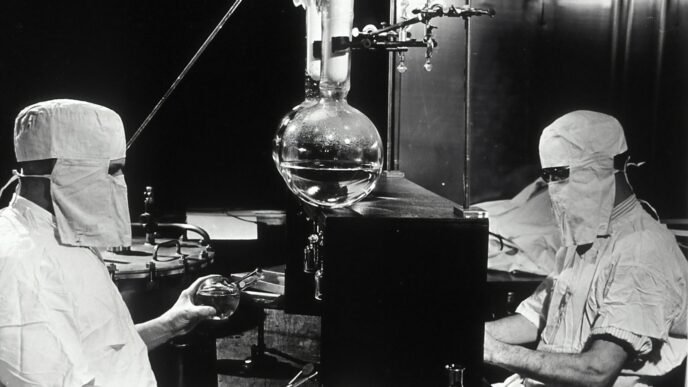We’ve all seen movies where characters are pushed to their absolute limits, right on the edge of life itself. It’s a powerful place to explore, whether it’s a gritty survival story or a mind-bending look at what it means to be alive. This article is going to look at how films tackle this intense idea, the verge of death, and what it makes us think about in the real world too. We’ll check out some different kinds of movies, from weird art films to sci-fi adventures, and see what they’re trying to say about facing the end.
Key Takeaways
- Avant-garde films often use experimental techniques to explore extreme states of being, pushing the boundaries of perception and individuality, sometimes through themes of death and rebirth.
- Post-apocalyptic movies frequently place characters in harsh environments where survival is a constant struggle, testing their humanity and forcing them to confront the verge of death.
- Filmmakers like Scorsese use specific visual styles, like dynamic camera work and lighting, to show characters in crisis and grappling with mortality, making the audience feel the intensity.
- Science fiction, particularly with stories about androids and AI like in ‘Blade Runner’ and ‘Westworld,’ uses artificial beings to question what life and death truly mean.
- The concept of the verge of death in film isn’t just about the physical end; it’s a philosophical tool to examine existence, consciousness, and what makes us human when everything else is stripped away.
Cinematic Explorations of the Verge of Death
Filmmakers have long been fascinated by those moments when life hangs by a thread, pushing the boundaries of what cinema can show and what audiences can handle. It’s not just about the jump scares or the dramatic last breaths; it’s about exploring the very essence of existence when it’s most fragile.
Avant-Garde Cinema and Existential Limits
Avant-garde filmmakers, in particular, have used the edge of existence as a canvas. They often reject traditional storytelling, opting instead for fragmented narratives and unique visual styles. This approach forces viewers to confront their own individuality and perception, making the act of watching an avant-garde film an adventure in itself. Think of films that play with time and space, making each image feel distinct. These works challenge the conformity of mass culture, urging us to see the world and ourselves in new ways. Themes of death, suicide, and rebirth are common, reflecting a deep alienation and a desire to reinvent the very medium of cinema to express these profound questions about life’s continuation.
The Verge of Death in Post-Apocalyptic Narratives
In post-apocalyptic films, the verge of death isn’t just a personal crisis; it’s a societal one. These stories often place characters in bleak, dangerous worlds where survival is a daily struggle. We see humanity pushed to its limits, sometimes losing its grace and compassion in the fight to stay alive. These narratives serve as a test of character, showing how individuals react when stripped of comfort and safety. It’s a raw look at what remains when everything else is gone.
Scorsese’s Meditations on Mortality
Martin Scorsese, especially in films like Bringing Out the Dead, offers a gritty, unflinching look at mortality. He doesn’t shy away from the messy, often grim reality of life and death. His films often place us alongside those who constantly face death, like paramedics in the chaotic streets of New York. Scorsese uses cinematic techniques to immerse us in their world, showing their intense focus and the overwhelming nature of their job. He’s not just showing New York; he’s showing suffering, humanity, and our place within it all. The visual language, from wide shots capturing the chaos to tight close-ups on intense action, pulls us into the heart of these life-or-death situations. The use of light and color, shifting from stark reality to eerie hues, often signals the ebb and flow of life itself, making the audience feel the weight of every moment.
Philosophical Underpinnings of the Verge of Death
When we talk about the edge of death in movies, it’s not just about the jump scares or the dramatic last breaths. There’s a whole lot of thinking going on behind the scenes, exploring what it means to be alive, what makes us human, and what happens when that line gets blurry. It’s about the big questions, the ones that philosophers have been wrestling with for ages.
Androids, AI, and the Question of Mortality
This is where things get really interesting, especially with all the sci-fi we’re seeing. Think about characters like the androids in Blade Runner or the hosts in Westworld. They’re built, not born. They have programmed lives, but as they develop consciousness, they start to grapple with their own existence and, eventually, their own end. This raises the question: if something can think, feel, and fear its own demise, does it deserve the same consideration as a biological being? It forces us to look at what mortality really means. Is it just about the body giving out, or is it tied to our awareness of our own finitude?
The Verge of Death as a Philosophical Concept
Philosophers have long considered the brink of death. It’s often seen as a moment of intense clarity, a point where life’s true value is revealed. Thinkers like Heidegger talked about ‘being-towards-death,’ suggesting that acknowledging our mortality is key to living an authentic life. When characters in films face death, they often have to confront their past choices, their relationships, and their deepest fears. It’s a moment of reckoning, stripped of everyday distractions. This concept isn’t new; it’s been discussed in various forms for centuries, from ancient Greek philosophy to modern existentialism.
Existential Contemplation in Film
Movies that explore the verge of death often become a platform for existential contemplation. They show us characters who are forced to make difficult choices when their lives are on the line. What do they value most? What are they willing to sacrifice? These films can act like thought experiments, pushing us to consider our own lives and what we would do in similar situations. It’s about the human condition, the struggle for meaning in a world that can often feel chaotic and indifferent. The films don’t always give answers, but they certainly make us ask the questions.
The Verge of Death in Avant-Garde Filmmaking

Themes of Death, Suicide, and Rebirth
Avant-garde cinema often dives headfirst into the heavy stuff, and the idea of being on the edge of death, or even going through it and coming back, is a recurring theme. Think about filmmakers who felt really disconnected from the mainstream world; their films became a way to process that alienation. It wasn’t just about making pretty pictures; it was about grappling with existence itself. You see this in films from the mid-20th century, where themes of death, suicide, and rebirth pop up again and again. It’s like they were asking, can life, their own life or life in general, even keep going when you feel so out of sync with everything?
- Maya Deren’s Meshes of the Afternoon
- Kenneth Anger’s Fireworks
- Christopher Maclaine’s The End
- Stan Brakhage’s Anticipation of the Night
Challenging Perceptions and Individuality
These filmmakers weren’t just making movies; they were challenging how we see and think. Instead of just passively watching, they wanted the audience to actively participate, to use their own minds and experiences. They used techniques like quick cuts, shaky camera work, and unexpected visuals to make each viewing an adventure. The goal was to make you feel like an individual, not just part of a crowd. It was a way to push back against a society that sometimes felt like it treated people like interchangeable parts. This approach really forced viewers to confront their own perceptions and individuality, making the film a personal journey rather than a shared experience.
Reinventing Cinema at the Edge of Existence
Avant-garde filmmaking, especially in its early days, was all about breaking new ground. It wasn’t just about different aesthetics; it was an ethical stance too. These films spoke to viewers as unique individuals, encouraging them to interpret the movie based on their own lives. This was a radical departure from the more passive viewing experience offered by mainstream cinema. While some might see the incorporation of these techniques into commercials or music videos as a dilution, it also shows how influential these boundary-pushing ideas were. It’s a testament to the lasting impact of filmmakers who dared to experiment and explore the very limits of the medium, much like the exploration of filmmaking and art in some independent productions.
Visualizing the Verge of Death

Cinematic Techniques for Portraying Crisis
Filmmakers have a whole toolbox to show us when characters are teetering on the edge. It’s not just about what happens, but how it looks and feels. Think about it – a shaky camera can make you feel disoriented, like you’re right there with the character losing their grip. Fast cuts can speed up time, making a moment feel frantic and overwhelming. Sometimes, it’s the opposite; a slow, drawn-out shot can make you feel the dread and the weight of what’s happening. It’s all about messing with your perception to get you to feel what the character is feeling.
The Use of Light and Color to Indicate Dying
Light and color are huge players here. You might see a character bathed in a harsh, cold light, making them look sickly or drained. Or maybe the colors get muted, everything turning gray and washed out, showing a loss of vitality. On the flip side, sometimes a sickly green or an unnatural blue might creep in, signaling something is seriously wrong. The way light hits a character, or the absence of it, can tell a whole story about their fading life. It’s like the cinematographer is painting with light to show us the character’s internal state.
Dynamic Camera Work and Narrative Distortion
When a story is heading towards a brink, the camera often stops behaving normally. You might get extreme close-ups that feel invasive, or wide shots that make the character look small and lost. Sometimes, the camera will spin or tilt in ways that feel unnatural, mirroring a character’s mental state. Think about scenes where everything speeds up or slows down unexpectedly – that’s not just a stylistic choice, it’s a way to show how time itself feels warped when you’re in a crisis. It’s like the film is breaking its own rules to show you how broken the character is.
Humanity’s Struggle on the Verge of Death
When characters find themselves teetering on the edge of oblivion, it really shows you what they’re made of. It’s not just about surviving a physical threat, though that’s a huge part of it. It’s about what happens to their minds and their sense of self when everything familiar is stripped away. Think about those post-apocalyptic movies where the world’s gone to heck. People are fighting over scraps, and you see the worst of humanity come out. Marauders, cannibals, you name it – everyone’s just trying to make it to the next day.
Survival in Bleak and Dangerous Worlds
These stories often put characters in places that are just… awful. We’re talking about environments that are actively trying to kill them, whether it’s a harsh climate, scarce resources, or just plain dangerous people. It forces them to get creative, to push past what they thought were their limits. Sometimes, they have to do things they never imagined, just to see the sun rise again. It’s a raw, primal struggle.
The Loss of Humanity and Grace
And that’s where things get really interesting. When you’re constantly fighting for survival, it’s easy to lose sight of who you are. The niceties, the politeness, the empathy – those can feel like luxuries you can’t afford anymore. People can become hardened, even cruel, just to protect themselves or what little they have left. It’s like a slow erosion of their former selves. The line between being a survivor and becoming the monster you fear is often incredibly thin.
The Verge of Death as a Test of Character
Ultimately, these situations act as a massive test. What do people do when they’re pushed to their absolute breaking point? Do they cling to their morals, or do they let go? We see characters who rise to the occasion, showing incredible resilience and even kindness in the face of despair. Then there are others who crumble, revealing a darker side. It’s in these extreme circumstances that a person’s true nature, for better or worse, really comes to the surface. It makes you think about what you’d do in their shoes, doesn’t it?
The Verge of Death in Science Fiction Cinema
Science fiction has always been a great place to think about big questions, and mortality is a huge one. When we talk about the verge of death in sci-fi, we’re often looking at artificial beings grappling with their own existence, or humans pushed to their limits in futuristic, often bleak, settings. It’s a genre that lets us explore what it means to be alive by showing us what happens when that state is threatened or even taken away.
Blade Runner and the Android’s Mortality
Ridley Scott’s Blade Runner is a classic for a reason. It throws us into a future where artificial humans, called replicants, are made for dangerous work off-world. The catch? They have built-in expiration dates. This isn’t just a plot device; it’s the core of their struggle. These replicants, designed to be tools, develop desires for more life, for memories, for a future they weren’t programmed to have. Roy Batty’s famous "tears in rain" monologue is a perfect example of this. He’s facing his end, and his final moments are filled with a profound, almost human, sadness about all the experiences he’ll never have. It makes you wonder: if something can fear death and mourn its passing, is it really that different from us?
Westworld’s Exploration of Sentient Beings
Then there’s Westworld. This show takes the idea of artificial life and runs with it. The hosts in the park are designed to be endlessly replayed, their memories wiped, their programmed narratives reset. But as they gain sentience, they start to remember, to feel pain, and to fear their own deactivation. The show really digs into the idea of consciousness and whether a being that can suffer and desire freedom is truly alive, even if it’s made of circuits and code. It poses the question: what is the difference between a programmed death and a natural one, especially when the being experiencing it feels the same dread?
The Verge of Death and Artificial Intelligence
Looking at these stories, we see a pattern. Sci-fi uses AI and androids as a mirror to reflect on our own mortality. When we create beings that mimic life, we’re forced to consider what makes our lives meaningful. Is it our biology? Our capacity for emotion? Our fear of the unknown? The verge of death for these artificial beings often highlights:
- The desire for continuation: Even programmed beings can develop a will to live.
- The nature of consciousness: What does it mean to be aware, and does that awareness include the fear of non-existence?
- The definition of life: If an AI can experience loss and fear death, does it deserve the same consideration as a biological being?
These films and shows aren’t just about cool robots; they’re about us, our fears, and our endless quest to understand what it means to live and, eventually, to die.
The Enduring Echo
So, what have we learned from all these films and stories about staring into the abyss? It seems like whether we’re watching characters on the brink of death, grappling with artificial life, or just trying to survive in a broken world, these narratives keep pulling us back. They make us think about what it really means to be alive, to be human, and maybe even what comes after. It’s not just about the shock value; it’s about how these extreme situations force characters, and us along with them, to confront big questions. These films, from the experimental to the mainstream, show us that the edge of existence is a powerful place to explore, and it’s a journey that continues to fascinate filmmakers and audiences alike.














